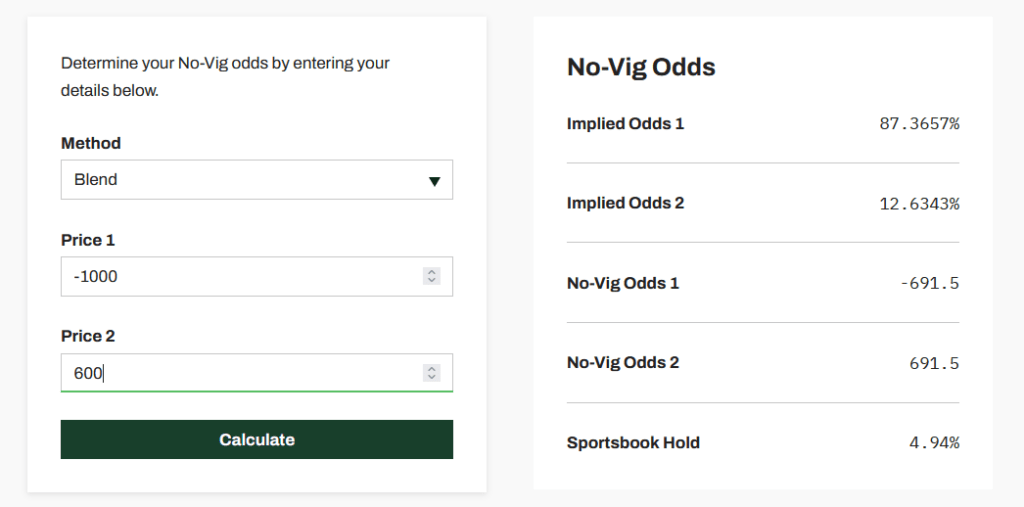Calculating no-vig odds, also known as fair odds, is an essential strategy for sharp bettors who want to strip away the bookmaker’s margin (vig) and focus on the true probabilities. Several methods exist, each offering a different perspective on how to remove the vig. Here, we’ll explore the main methods and their pros and cons.
The Five Most Popular No-Vig Methods
Let’s jump right in! Here are the five most popular methods for calculating the no-vig in sports betting.
Equal Margin (EM)
Overview: This method distributes the bookmaker’s margin evenly across all outcomes.
- Positives:
- Simple and easy to calculate.
- Provides a straightforward approach that works well for markets with evenly matched outcomes.
- Ideal for beginners or quick estimates.
- Negatives:
- Doesn’t account for differences in how much margin should be applied to different outcomes.
- Can be less accurate in cases where the outcomes are heavily skewed (e.g., a strong favorite vs. an underdog).
Margin Proportional to Odds (MPTO)
Overview: This method adjusts the probabilities so they sum to one, removing the vig proportionally based on the odds.
- Positives:
- More accurate than EM in markets with uneven outcomes, as it adjusts based on the actual odds.
- Still relatively easy to calculate with basic math skills.
- Works well in a variety of betting markets.
- Negatives:
- May not be as intuitive for some users compared to EM.
- Slightly more complex when trying to apply it quickly across multiple bets.
Shin Method (SHIN)
Overview: This approach takes into account the possibility that some bets are more informed than others, which can lead to a more nuanced calculation.
- Positives:
- Adds a layer of sophistication by considering the likelihood of “informed” bettors influencing market odds.
- Helpful in markets where there’s significant sharp action or high-volume betting.
- Negatives:
- More complex and not as easy to calculate manually.
- Assumes a certain level of market efficiency, which may not always hold.
- Requires additional data, such as informed bet percentages, to be truly effective.
Odds Ratio (OR)
Overview: A simple method that adjusts the odds by dividing them by the sum of all odds.
- Positives:
- Straightforward and easy to apply.
- Works well for comparing multiple outcomes.
- Can be used quickly in scenarios where odds are readily available.
- Negatives:
- May oversimplify complex markets with wide disparities in odds.
- Lacks the nuance of other methods, potentially leading to less accurate fair odds in skewed markets.
Logarithmic Method (LOG)
Overview: This method uses logarithms to adjust the odds and provide a more sophisticated approach to calculating fair odds.
- Positives:
- Offers a unique mathematical perspective that can be highly accurate in markets with extreme odds differences.
- May highlight small discrepancies that other methods might miss.
- Negatives:
- Very complex and difficult to calculate without the right tools or software.
- Not always intuitive or practical for everyday betting purposes.
Which Method is Best?
I think that a blend of Equal Margin (EM) and Margin Proportional to Odds (MPTO) offers the most practical solution. These two methods are easy to calculate and provide a balanced approach, making them suitable for most betting situations. This is what we call the “Blend” approach on our calculator at GamedayMath. While more complex methods like the Shin or Logarithmic approaches can add extra precision, they are often overkill for day-to-day sports betting.
Ultimately, comparing results from multiple methods can help you gain a deeper understanding of the fair odds, but for most bettors, the combination of EM and MPTO strikes the right balance of simplicity and accuracy.
